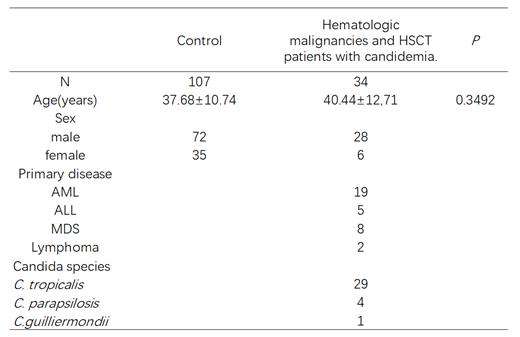1.Backgroud
In recent years, the number and proportion of deaths from fungal infections have increased year by year. The fatality rate of fungemia is about 0.4 per 100 000 [Pfaller MA, et al. Clin Microbiol Rev. 2007]. Chemotherapy can effectively treat hematological malignancies. Data from multi-center studies in China show that the overall mortality rate of patients receiving chemotherapy for hematological malignancies is only 1.5%, and the mortality rate of patients with clinically diagnosed invasive fungi is as high as 11.7% [ Sun Y, et al. Tumor Biol, 2015]. The surveillance data of China Hospital Invasive Fungal Disease Surveillance Network from 2015 to 2017 showed that Candida albicans was the most common pathogen among 4 010 Candida strains isolated from patients with candidemia from 77 hospitals in China [Xiao M, et al. J Infect Dis, 2020].
2.Methods
We conducted a retrospective study that collected relevant clinical information from 34 hematologic malignancies and hematopoietic stem cell transplantation (HSCT) patients with candidemia between 2017 to 2022 in Hematology Hospital, Chinese Academy of Medical Sciences. The blood specimens of patients suspected to have candidemia were collected and cultured. After diagnosis, they were regarded as the candidemia group, and 107 healthy people were selected as the control group. Candidemia is classified as invasive or non-invasive according to whether it involves tissues or organs damage. Blood routine and clotting related tests were performed at the Clinical Laboratory Center of Hematology Hospital, Chinese Academy of Medical Sciences.
3.Results
3.1 General Characteristics of the Study Subjects
A total of 34 hematologic malignancies and HSCT patients with candidemia were recruited. Of these 34 patients, 28 were male and 6 were female. Meanwhile, 107 healthy people were recruited as control group. The characteristics of two groups are presented in Table 1.
3.2 Hematologic malignancies and HSCT patients with abnormal blood routine are at increased risk of candidemia
Hematologic malignancies and HSCT patients with candidemia present as lower white blood cell count, lower red blood cell count, higher lymphocyte ratio, lower lymphocyte count, lower monocyte count, lower neutrophil count and ratio, and lower NEU/PLT compared with control group.
3.3 Candidemia cause platelet activation in hematologic malignancies and HSCT patients
The PLT and PCT of hematologic malignancies and HSCT patients with candidemia were significantly lower than control group. Meanwhile, MPV and P-LCR were higher than control group. It revealed that hematologic malignancies and HSCT patients with candidemia may present with platelet activation, while PLT and PCT level were low in this group.
3.4 Invasive candidemia can cause a decrease in platelets and an increase in MPV/PLT
Furthermore, we found that PLT level was lower and MPV/PLT level was higher in hematologic malignancies and HSCT patients with invasive candidemia than hematologic malignancies and HSCT patients with non-invasive candidemia.
3.5 Candidemia can cause coagulation dysfunction in hematologic malignancies and HSCT patients
Hematologic malignancies and HSCT patients with candidemia had coagulation dysfunction symptoms such as prolonged PT and APTT, reduced antithrombin III activity, and high INR.
3.6 Candidemia can cause hyperfibrinolysis in hematologic malignancies and HSCT patients
Meanwhile, hematologic malignancies and HSCT patients with candidemia showed reduced TT, increasing fibrinogen, fibrinogen degradation products, and D-Dimer.
4.Conclusion
In conclusion, we demonstrated for the first time that decreasing platelet count and activated platelet function in hematologic malignancies and HSCT patients with candidemia. Invasive candidemia may cause lower platelet count and more activated platelet function in hematologic malignancies and HSCT patients. At the same time, we found that candidemia can cause coagulation dysfunction and hyperfibrinolysis in hematologic malignancies and HSCT patients. We hope that our study can provide a new perspective on the cognition and diagnosis of hematologic malignancies and HSCT patients with candidemia.
Disclosures
No relevant conflicts of interest to declare.


